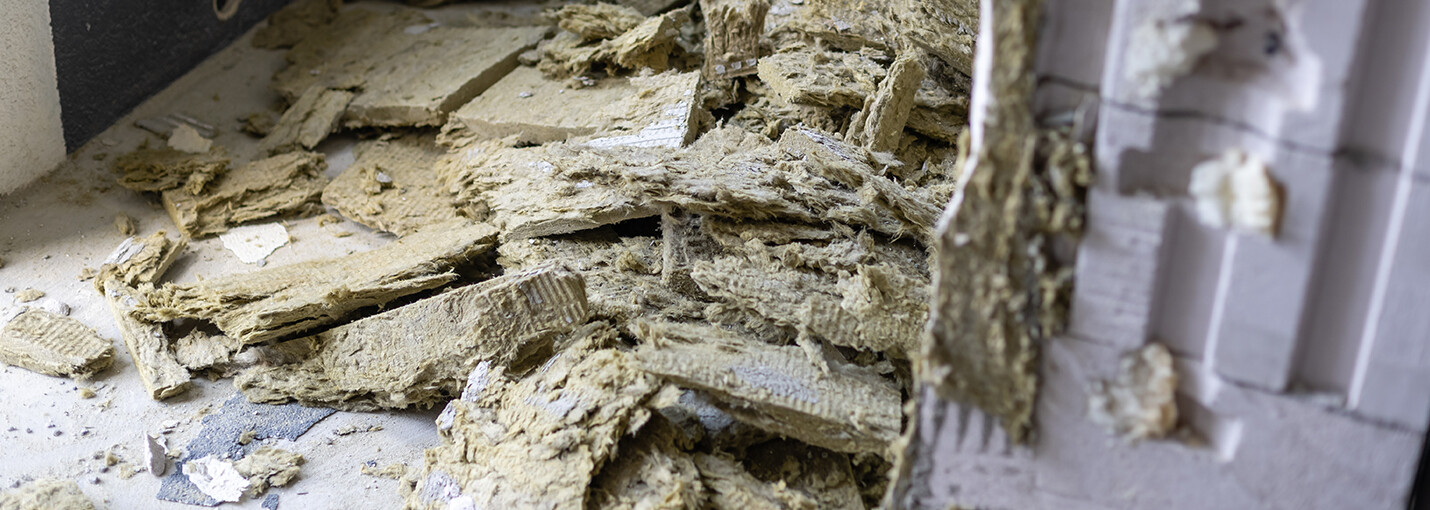How Do You Remove Asbestos from an Old House Before Demolishing It?
Before the 1980s, asbestos was a significant driving force behind industrialization in many countries, including the U.S. That is due, in large part, to the fact that it came with a wide range of potential applications, and was, therefore, be used in a variety of ways.
At the time, the public didn’t understand the risks of using asbestos, which wouldn’t become widely publicized until years later. Of course, everything changed in the mid-1980s when awareness of the dangers of asbestos – long covered up by companies turning a substantial profit – grew, and the U.S. Environmental Protection Agency (EPA) stepped in to regulate it.
!
If you believe that you were exposed to asbestos, even as a child, speak to a healthcare provider about tests and screening to help diagnose lung-scarring and screen for asbestos-related diseases.
Asbestos: From miracle mineral to major threat
As a result, many products manufactured before this time contain the once-hailed “miracle mineral,” and that means that individuals are still at risk of exposure. The construction industry is one of the biggest culprits. Asbestos fibers were used in everything from flooring, walls, ceilings tiles, roofs, wiring, and plumbing because of the mineral’s inexpensiveness, durability, pliability, and heat resistant properties.
 |
| Nearly every building constructed before the mid-1980s contained asbestos products and building materials. |
 |
In today’s rapidly growing society where demolitions are part and parcel of everyday life, it’s vital that older properties are properly inspected before moving forward. Otherwise, friable asbestos might easily be ingested, causing significant health issues, and property owners could open themselves up to asbestos litigation.
Sharing a home or vehicle with someone wearing asbestos-tainted clothing puts you at risk of asbestos-related diseases. 1 2 3 4 5
What are the Dangers of Asbestos?
Asbestos is a mineral that is harmless in its natural state because it has yet to be disturbed. However, once mined and processed, it is converted into fibers, which are highly friable, meaning they can travel via air, water, or soil. Once these fibers are ingested, they lodge against organ tissues and lead to irritation, inflammation, and injury. With accumulation, diseases such as asbestosis, mesothelioma, and many different forms of cancer can occur.
“Generally, those who develop asbestos-related diseases show no signs of illness for a long time after exposure.”Source: National Cancer Institute (NIH)6 |
The problem with asbestos-related illnesses is that they can take a considerable amount of time to develop, with a typical symptom latency period of between 30-50 years. By the time symptoms are evident, asbestos has been lodged in the body long enough to cause significant damage, and diseases are likely to have already progressed.
Asbestos related diseases can take 20 to 50 years to appear.
The latency of symptoms is one of the primary reasons why the dangers of asbestos have been gaining attention in recent years. Those exposed prior to the large-scale EPA ban in the ‘80s are just now exhibiting signs of disease. These individuals likely came into contact with the microscopic fibers in everyday life during asbestos’ heyday, and remained unaware of the issues they’d face until long after the fact.
Asbestos has no taste or smell.
You may not know you’re breathing it.


Demolishing an old house that may contain asbestos: Proceed with caution
Due to the risks of asbestos, it is imperative that any demolition of a property built prior to the 1980s proceeds with caution. For starters, a property owner shouldn’t handle the demolition themselves unless they just so happen to be a licensed asbestos abatement contractor. Proper handling of asbestos is needed before demolition to avoid endangering lives. And aside from personal, moral, and societal responsibilities, doing so could also open an owner up to litigation.
“The overall evidence suggests there is no safe level of asbestos exposure.”Source: National Cancer Institute (NIH)7 |
There are federal, state and local laws regarding the appropriate handling and disposal of asbestos, which need to be followed in order to guarantee health and safety as well as EPA compliance. Moreover, if a demo or renovation project is being done in order to sell a property, improper removal could negatively impact the sale. Obtaining certification proving that asbestos has been entirely removed will help.
“Some asbestos fibers may bypass…your body’s natural defenses…and lodge deep within your lungs. Those fibers can remain in place for a very long time and may never be removed.”Source: American Lung Association |
Steps to take when demolishing a house to prevent asbestos exposure
Here are the steps that should be taken in order to test for asbestos and remove any present before a demo or renovation proceeds:
1. Conduct an asbestos audit.
The first step is to determine whether asbestos is present, and if so, how much. This is essentially a risk assessment report conducted by a licensed asbestos auditor. Only companies that are accredited by the EPA are qualified to carry out an asbestos audit – in other words, a general home inspector may not carry the credentials to do so.
“All forms of asbestos are carcinogenic to humans.” 8
EPA-accredited asbestos audits are mandated by federal, state, and sometimes local regulations, meaning there are laws that require an owner to identify the presence of any asbestos-containing materials (ACMs) prior to demolition. The approach to removal differs depending on the severity of the information recorded in the audit, which will sub-divide the issue into categories – either Category I or Category II, non-friable ACM.
Do You Qualify For Compensation?
Quickly and easily find out how you were exposed by searching W.A.R.D., the largest asbestos database on the planet.
FREE SEARCH >2. Contact an asbestos lawyer.
It may seem extreme to get a lawyer involved. However, this is one of the first steps that should be taken in any asbestos-related situation. As mentioned previously, there are various federal, state, and local regulations on the handling of ACMs. Therefore, it’s important to have an attorney confirm legalities are followed every step of the way.
A lawyer can also conduct a legal risk assessment to help a property owner determine whether demoing is worthwhile. Essentially, asbestos attorneys can help ensure a person understands their legal rights and is compliant every step of the way.
3. Conduct a thorough assessment of removal companies.
This is perhaps the most intensive part of the process, because it’s important for a property owner to do their homework when it comes to selecting an asbestos auditor and abatement contractor, and this can take time. Shopping around and receiving multiple quotes while vetting companies can help ensure the job is done right and for the right price.
4. Conduct an asbestos removal review.
After removal, a review should be done to confirm a property has been properly remediated. The company that conducted the audit could also conduct a review and will ascertain whether the ACMs have been properly disposed of, per regulations. If everything is up to par, the company will issue an asbestos clearance certificate and demolition can commence.
Over $30 Billion is still available (No lawsuit. No fees unless you receive money. No risk.) Stake your claim.  |
The bottom line on asbestos before demolishing an old house
To keep you and your family healthy and out of court, bring in professionals to handle asbestos auditing and removal prior to demolition. The advice of a seasoned asbestos attorney, such as those at AsbestosClaims.law, can prove to be invaluable throughout this process. Accreditation is also the most important thing to consider when hiring a company for asbestos audit, removal, or review, and proper documentation is key. Whether it is the audit results, a company’s accreditation certificate, or an asbestos clearance certificate, obtaining each will help prove a demolition project was done in compliance with federal, state, and local regulations.
AsbestosClaims.Law
At AsbestosClaims.Law, our mission to secure compensation for asbestos victims is more than professional; it’s personal.
Our founder, Justinian C. Lane, understands the devastating impacts of asbestos firsthand.
Both his grandparents and father, all asbestos workers, passed away from asbestos-induced cancers without realizing their eligibility for asbestos lawsuits or other forms of compensation.
We aim to prevent such tragic oversights by informing and guiding victims and their families through their legal options.
If you or your loved ones have suffered as a result of asbestos exposure, you could be eligible for considerable compensation. These funds could provide for medical treatments, asbestos removal services, and safeguard your health.
In addition, asbestos trusts offer compensation without the need for a lawsuit, providing a quicker, simpler path to justice.
Reach out to us at [email protected] or (206) 455-9190 for assistance with your claim. We offer compassionate listening, clear explanations, and we don’t charge a dime unless we win your case.
Beyond legal claims, we also advise on veterans’ disability, social security, and employment protection like workers’ compensation, FELA, and The Jones Act for maritime workers.
There’s no risk or cost to connect with our experienced team about your rights. Our commitment to your well-being means no fees unless you receive compensation.
| For further queries or concerns about asbestos, explore our website and YouTube page, featuring infographics, videos, and answers to common questions on asbestos-related topics. |
We’ve also introduced W.A.R.D., the Worldwide Asbestos Research Database. It’s the most comprehensive resource for asbestos-related information.
W.A.R.D. assists in pinpointing potential exposure scenarios, asbestos-containing products, and can indicate the types and potential amounts of compensation you may be entitled to receive.
Don’t delay — get in touch with us today!
Scholarly Source:Understanding asbestos management and removal. , Tribich, J. (2021). Built Environment Journal.
1 Anua, S.M., Semple, S., Shakri, S.F.M., Safuan, S., Mazlan, N. and Asri, A.A.M., 2019. A review of the take-home exposure pathway of workplace hazards. International Journal of Medical Toxicology & Legal Medicine, 22(3and4), pp.13-19.
2 Ferrante, D., Bertolotti, M., Todesco, A., Mirabelli, D., Terracini, B. and Magnani, C., 2007. Cancer mortality and incidence of mesothelioma in a cohort of wives of asbestos workers in Casale Monferrato, Italy. Environmental Health Perspectives, 115(10), pp.1401-1405.
3 Miller, A., 2005. Mesothelioma in household members of asbestos‐exposed workers: 32 United States cases since 1990. American journal of industrial medicine, 47(5), pp.458-462.
4 Reid, A., Heyworth, J., De Klerk, N. and Musk, A.W., 2008. The mortality of women exposed environmentally and domestically to blue asbestos at Wittenoom, Western Australia. Occupational and environmental medicine, 65(11), pp.743-749.
5 İşten, B.H.S.T.O. and Maruziyetler, E.T., 2021. Exposures Moved from Work to Home as a Public Health Hazard.
6 National Cancer Institute (NIH), Asbestos Fact Sheet.
7 National Cancer Institute (NIH), Asbestos Fact Sheet.
8 IARC Working Group on the Evaluation of Carcinogenic Risks to Humans. Arsenic, metals, fibres, and dusts. IARC Monographs on the Evaluation of Carcinogenic Risks to Humans. 2012 ;100(Pt C):11-465. PMID: 23189751.